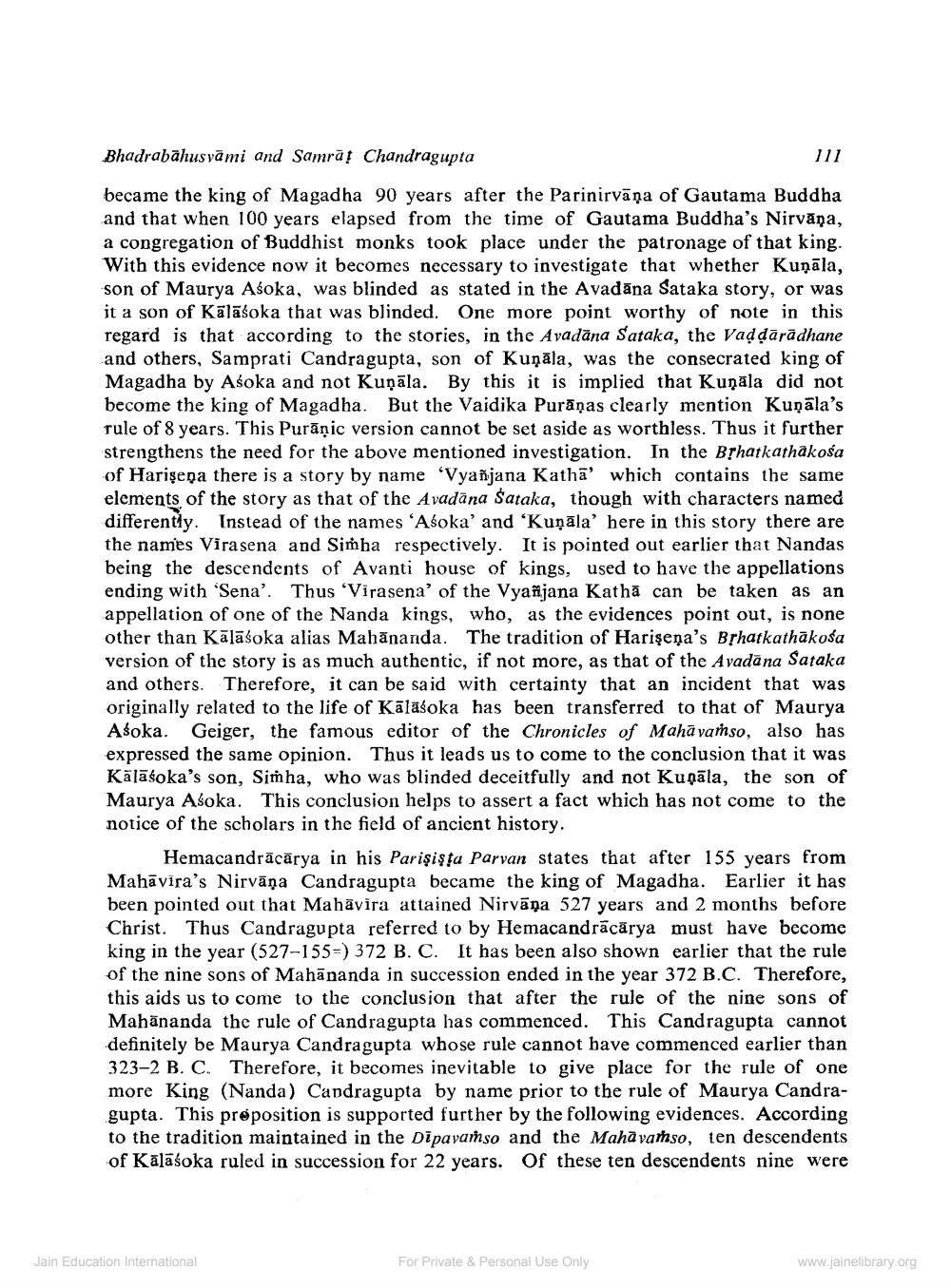________________
Bhadrabāhusvāmi and Samrai Chandragupta
became the king of Magadha 90 years after the Parinirvāņa of Gautama Buddha and that when 100 years elapsed from the time of Gautama Buddha's Nirvāṇa, a congregation of Buddhist monks took place under the patronage of that king. With this evidence now it becomes necessary to investigate that whether Kuņāla, son of Maurya Asoka, was blinded as stated in the Avadāna Sataka story, or was it a son of Kālāsoka that was blinded. One more point worthy of note in this regard is that according to the stories, in the Avadāna Sataka, the Vad dārādhane and others, Samprati Candragupta, son of Kuņāla, was the consecrated king of Magadha by Aśoka and not Kuņāla. By this it is implied that Kuņāla did not become the king of Magadha. But the Vaidika Purāṇas clearly mention Kuņāla's rule of 8 years. This Purāṇic version cannot be set aside as worthless. Thus it further strengthens the need for the above mentioned investigation. In the Bșhatkathākosa of Harişena there is a story by name 'Vyañjana Katha' which contains the same elements of the story as that of the Avadāna Sataka, though with characters named differentiy. Instead of the names 'Asoka' and 'Kuņāla' here in this story there are the names Vira sena and Simha respectively. It is pointed out earlier that Nandas being the descendents of Avanti house of kings, used to have the appellations ending with 'Sena'. Thus 'Virasena' of the Vyañjana Kathā can be taken as an appellation of one of the Nanda kings, who, as the evidences point out, is none other than Kālāsoka alias Mahānanda. The tradition of Harişeņa's Brhatkathākoša version of the story is as much authentic, if not more, as that of the Avadana Sataka and others. Therefore, it can be said with certainty that an incident that was originally related to the life of Kālašoka has been transferred to that of Maurya Asoka. Geiger, the famous editor of the Chronicles of Mahā vamso, also has expressed the same opinion. Thus it leads us to come to the conclusion that it was Kālāšoka's son, Simha, who was blinded deceitfully and not Kuņāla, the son of Maurya Asoka. This conclusion helps to assert a fact which has not come to the notice of the scholars in the field of ancient history.
Hemacandrācārya in his Parişişța Parvan states that after 155 years from Mahāvira's Nirvāņa Candragupta became the king of Magadha. Earlier it has been pointed out that Mahavira attained Nirvāna 527 years and 2 months before Christ. Thus Candragupta referred to by Hemacandrācārya must have become king in the year (527-155=) 372 B. C. It has been also shown earlier that the rule of the nine sons of Mahānanda in succession ended in the year 372 B.C. Therefore, this aids us to come to the conclusion that after the rule of the nine sons of Mahānanda the rule of Candragupta has commenced. This Candragupta cannot definitely be Maurya Candragupta whose rule cannot have commenced earlier than 323-2 B. C. Therefore, it becomes inevitable to give place for the rule of one more King (Nanda) Candragupta by name prior to the rule of Maurya Candragupta. This preposition is supported further by the following evidences. According to the tradition maintained in the Dipayamso and the Mahavamso, ten descendents of Kālāśoka ruled in succession for 22 years. Of these ten descendents nine were
Jain Education International
For Private & Personal Use Only
www.jainelibrary.org




